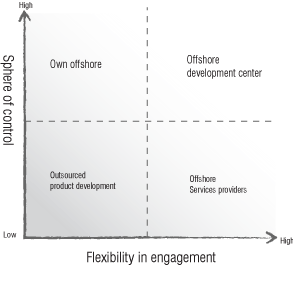Offshoring is, at the core, a practice that involves moving a part or all of a company’s processes to a foreign country for a plethora of reasons ranging from lowering costs to increasing efficiency. It has been an immensely effective go-to solution for ISVs at various stages of growth:
- ISVs that have a well running R&D department, but need to expand capacity
- ISVs that want to migrate to new technology, but do not have the resources to actually do it
- ISVs that want to innovate, but do not have the right people or can’t get them locally
Not surprising then, that over 80% of the world largest software vendors are
already offshoring!
 Whenever an organisation is looking to outsource or go offshore, various questions arise. These are centered around where to start and which engagement model to follow. Most of these questions originate from either the fear-of-the-unknown or case studies of successes and failures in offshoring or outsourcing endeavors.
Whenever an organisation is looking to outsource or go offshore, various questions arise. These are centered around where to start and which engagement model to follow. Most of these questions originate from either the fear-of-the-unknown or case studies of successes and failures in offshoring or outsourcing endeavors.
Owing to the highly competitive nature of the market we thrive in, there is an inherent need to seek out new ways to increase productivity and efficiency. It should also be noted that the success and failure of a model doesn’t depend entirely on the model itself but also, and more importantly, on its implementation. Let’s consider commonly engaged models in the
software offshoring and outsourcing industry.
To truly succeed in your offshoring initiative, ensure that your choice of an engagement model is based on strategic intent. As mentioned earlier, certain basic questions and concerns still bother decision makers when embracing an offshoring or outsourcing strategy. Here is an attempt to demystify some of the popular concerns in a very
practical and unbiased manner.
Balanced Sourcing: Solving a problem within the mindset that created it can be difficult. However, in outsourcing, assuming that others will solve what you can’t can be a difficult proposition. Look for competency compatibility in your partner so that you can focus on your strengths while allowing your partner to do what they do best.
Culture doesn’t matter. Good processes do: A different culture is not a difficult culture. Focus on competency compatibility rather than cultural compatibility so that time and energy is well spent focusing on things that yield substantial business benefits.
Cheap is expensive?: A common perception is that since you get several rupees for a Euro, you can buy more. But, when the result of this investment is that you spend more Euros to repair your product, the cost advantage quickly disappears. Hence, you need to set the right quality and invest accordingly and cost savings will be a positive outcome from it.
Shuttle Diplomacy: Software development is a people and knowledge-centric business. The process of setting up and operating a distributed innovation involves aligning people, their knowledge and the overall business ambition of the company.
Copyright is never a right to copy: It is crucial to have shared values and principles when it comes to respecting each other’s intellectual property. Choosing an outsourcing or offshoring partner should be a very meticulous and well thought out decision because it is much more than just a regular transaction.
Keeping it right: When pursuing offshoring or outsourcing endeavors, it is crucial to make decisions based on context. Determine with certainty your reason for offshoring the software development process. While there is always going to be an uncertainty factor, contextual decision-making in offshoring will help drive better results.





